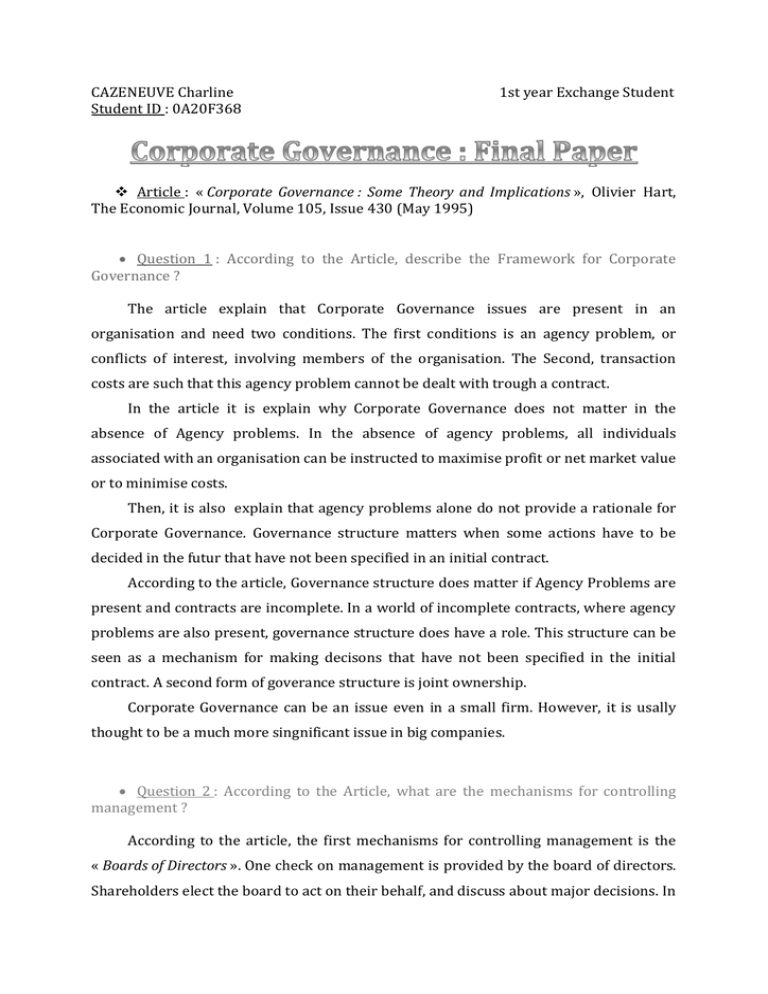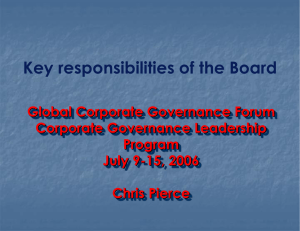Document 15903779
advertisement

CAZENEUVE Charline Student ID : 0A20F368 1st year Exchange Student Article : « Corporate Governance : Some Theory and Implications », Olivier Hart, The Economic Journal, Volume 105, Issue 430 (May 1995) Question 1 : According to the Article, describe the Framework for Corporate Governance ? The article explain that Corporate Governance issues are present in an organisation and need two conditions. The first conditions is an agency problem, or conflicts of interest, involving members of the organisation. The Second, transaction costs are such that this agency problem cannot be dealt with trough a contract. In the article it is explain why Corporate Governance does not matter in the absence of Agency problems. In the absence of agency problems, all individuals associated with an organisation can be instructed to maximise profit or net market value or to minimise costs. Then, it is also explain that agency problems alone do not provide a rationale for Corporate Governance. Governance structure matters when some actions have to be decided in the futur that have not been specified in an initial contract. According to the article, Governance structure does matter if Agency Problems are present and contracts are incomplete. In a world of incomplete contracts, where agency problems are also present, governance structure does have a role. This structure can be seen as a mechanism for making decisons that have not been specified in the initial contract. A second form of goverance structure is joint ownership. Corporate Governance can be an issue even in a small firm. However, it is usally thought to be a much more singnificant issue in big companies. Question 2 : According to the Article, what are the mechanisms for controlling management ? According to the article, the first mechanisms for controlling management is the « Boards of Directors ». One check on management is provided by the board of directors. Shareholders elect the board to act on their behalf, and discuss about major decisions. In extreme cases the board may replace the company’s chief executive and other members of the management team. In principle, the board has a very important role to play, but in practice there are some reasons to doubt about its effectiveness. In a board, there is executive directors, who are members of the management team, and nonexecutive directors, who are outsiders. Several problems exists between this two type of directors. For example, the executive directors have a significant financial interest in the company, when the nonexecutive directors are busy people and probably have little time to think about the company’s affairs. To solving problems of boards, the article explain it would be a good idea to change the structure of the board. For example, it is recommended that the chairman of the board should be independant. Suggestions in this article are not enough to solve completely all problems in board. An other mechanisms for controlling management according to the article is « Proxy fights ». If the performance of board members is sufficiently bad, shareholders can always replace them. The standard way this is done is through proxy fight : a dissident shareholder puts up a slate of candidates to stand against management’s slate and tries to persuades other shareholders to for his or her candidates. Proxy fights may not be very powerful tool for disciplinning directors in a company with dispersed sharholders. The third mechanisms in the article is « Large sharholders ». It is explain that one way to improve Coporate Governance is to ensure that a company has one or more large sharholders. For example, if a company has a 100% shareholder there is no longer separation between ownership and control. Own 100% of a company for only one shareholder would create several problems. This large sharholder may use his power to improve his own position at the expense of other sharholders. He might persuade management to divert profit to himself, for example by selling goods to a company the shareholder owns at a high price. To improve Corporate Governance, company has to make sure having more than one large shareholder. The fourth mechanisms for controlling management in the article is about « Hostile Takeovers ». It’s explain that a hostile takeover is in principle a much more powerful mechanism for disciplining management since it allows someone who identifies an underperforming company to obtain a large reward. The last one mechanisms in the article is about the « Financial Structure ». The article explain that all the mechanisms discussed before all involve monitoring or voting by shareholders or their representatives. But another important source of discipline on managers is provided by corporate financial structure.



